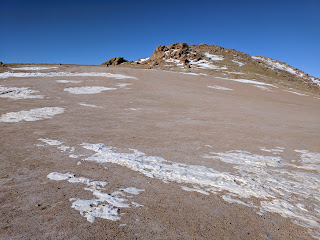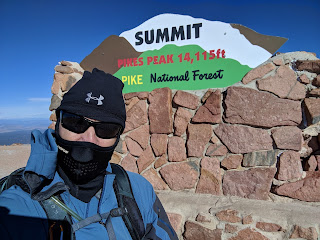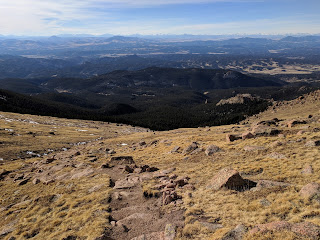14,047' Culebra Peak (which means "snake" in Spanish, and since nearly every report I've ever seen regarding this peak includes that bit of information, I figure I may as well keep the tradition alive by doing it here) is unique in that it is part of the private Cielo Vista Ranch, which only allows limited access to the summit of Culebra on weekends during a couple months of the summer. Reservations to climb have to be made in advance, and the 20-25 slots per climbing day usually go very quickly, so I was excited to have been able to get mine right as they were publicly made available. Joining me on this climb would be Nicole Smathers, Kim Styles and Laura Chren.
We drove down to Fort Garland CO the day before so that we could shorten a 4-5 hour drive to the property gate from Longmont to about 45 minutes. After a typical restless night, we headed out about 5:00 am. At 5:45, we met the property manager who let us and maybe a dozen other parties who had camped out at the gate that night onto the property. We drove a couple miles to a ranch house where we checked in, then drove about 4 miles up a relatively easy but steep 4wd road to the upper parking area. By about 6:45 am, we had started hiking.
We would be doing the standard NW Ridge route, which is about 5-6 miles round trip but can vary somewhat because there is no trail here, though the path is pretty obvious. Right out of the parking lot, we climbed about 1.4 miles up a 1500 foot slope to reach a ridge at about 13,300'.
The picture above doesn't nearly show how much elevation you have to gain to get to the ridge. Below looks back from maybe 1000' up the face, where the parking lot is out of view just below treeline.
On the ridge, there is a giant cairn to aim for that marks the beginning of a short drop into a saddle before heading up the NW ridge of Culebra as seen in the distance below.
Thankfully a big chunk of elevation was gained to this point, but there was still a good 1000' to climb over this ~1.5 mile ridge.
The views to the north from this ridge were really amazing. Below, 13,436' "Punta Serpiente" can be seen above Carneros Lake to the north. The cairn in the previous pic would be on the left side of the ridge in the pic below, and Punta Serpiente is the high point on the right of this ridge. We would be going to that summit after we were done with our primary task at hand.
The ridge started as rocky tundra but quickly turned into mainly talus, some that required some easy scrambling to get through. Most of the way up, there was a high point ahead that I knew was a false summit, but it made for a good point to aim for.
The true summit couldn't be seen at this point, and even though I knew it was still a good half mile beyond the false summit, it still surprised me how much farther we had to hike to get there.
Fortunately, we only had a couple hundred more feet to gain along this final ridge, so it was a pretty easy finish. The views, as usual at this elevation, were incredible on this clear day.
Looking to the north:
Looking west back along the ridge into the desert-like San Luis Basin. The false summit we had to pass is the hump on the right of the picture:
The Spanish Peaks were visible to the northeast. These 13.5k and 12.6k peaks look spectacular because there is nothing else near them:
To the north, the lower group of Sangre de Cristo 14ers could be seen in the distance (Little Bear, Blanca, Ellingwood Pt, and Lindsey. The Great Sand Dunes can't be seen but are just behind and slightly left of these peaks in the background:
13,908' Centennial Red Mountain, which is about a mile one way from the summit of Culebra, is often combined with it. I had expected to summit it with anyone who wanted to join me, however over the course of our summit of Culebra, the wind had really began to whip up strongly, and none of us felt like traversing to and from Red (one must re-summit Culebra to get back) in a wind tunnel. It would have to wait for another day.
Our group at the summit. I've been on many summits, 14ers and otherwise, with these great friends.
This was my 38th 14er. It is getting more and more difficult to get the required number of fingers in the picture without it looking a bit awkward, but there is no time for awkward when one is documenting 14er ascents.
We spent nearly an hour on the summit, much of it huddled behind a wind shelter refueling, taking pictures and convincing ourselves that we'd be better off not to try to tag Red Mountain. When we arrived, there were about a dozen others on the summit, and as we headed out, one had just returned from Red and another group of 4 had made there way up from the lower trailhead.
This picture of Kim and Nicole descended shows what much of the upper slope looked like. By now the wind was fierce and pretty constant and made the descent a bit more of an uncomfortable challenge.
In lieu of Red Mountain, we decided to summit Punta Serpiente on the way down, which would add maybe another mile and a hundred feet of gain but would provide us with a new and beautiful perspective of the basin we'd been skirting all morning. In the picture below, the summit of Culebra is the high bump on the right of the pic, a couple miles away.
The view west was still incredible from here. Sanchez Reservoir can be seen in the center in the distance. We would be heading down this rocky talus face to get back to the car.
From our descent on the opposite side of this face on which we started our climb, we could see our initial route that started just below treeline in the bottom of the valley on the right, immediately climbed that ridge near the center, then worked up the ridge to the left side of the picture.
Again, the picture doesn't do it justice, but this was a pretty vast face of tundra, much of it covered with small flowers. This was taken just before we got back to the parking area.
In all, we were out nearly 7 hours over the course of 5-6 miles roundtrip, depending on whose tracking device you trusted the most. Nicole had recently climbed Pikes Peak and was grateful for a much more compact and scenic hike on Culebra. It was her 36th 14er. This was Kim's 20th 14er and first since last year if I'm not mistaken. Laura had been earning her masters in Florida and Mexico over the past couple of years and has recently returned home to Colorado for her first 14er summit since then. Word has it that she'll be out doing a couple more this week.
All of Colorado saw very little snow this winter and much of it is in a severe drought, so summer conditions have come early to most of the tall peaks here this year and there are already some major fires burning. Fortunately the Sangres have not seen fires break out yet, and we were lucky enough to get to enjoy more unique scenery from Colorado's southernmost 14er.









































































